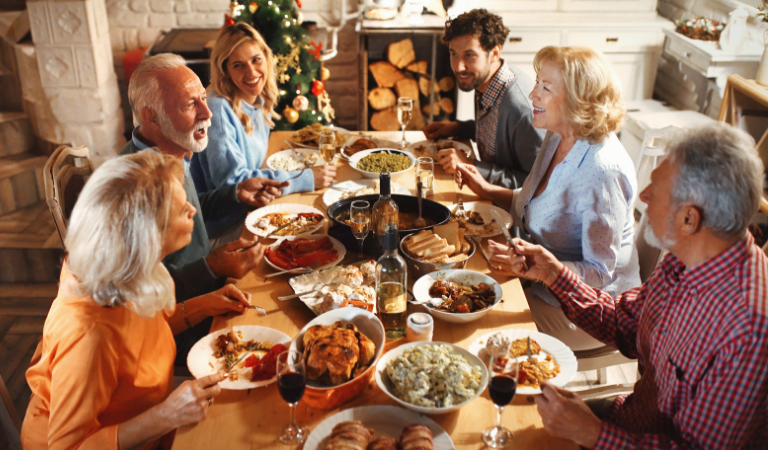Family-style dining – sometimes called large-format dining – can be viewed as a hybrid between a traditional table-service experience and buffet-style dining. It is when food is brought out to guests on large plates or platters and each individual serves themselves. The food is brought out to the table by a server, rather than guests standing up to get food on their own. There’s no risk of over-ordering or under-ordering food since servers bring out large portions at a time, and will only bring out more food if necessary.
Benefits of Family-Style Dining
Large-format dining can be a great option when going to eat with a group of friends or family. At a family-style restaurant, diners can enjoy a meal with their loved ones. Everyone gets the opportunity to serve their own plates, so portions are not predetermined. This allows everyone to serve exactly how much they want to eat, as well as specifically what they want on their plate. They have the option of trying a little bit of everything that is brought out, so it alleviates the worry of choosing which dish from the menu to order.
Another unique feature of family-style dining is that it mimics family dinners, hence the name “family-style.” It inspires communication at the table, providing a comfortable and social experience. People bond over shared experiences and food, so by combining the two, it creates the ideal situation for connection. Experiencing a meal together – and actually sharing a meal – gives guests the opportunity to connect with others. 
Something parents love about the idea of family-style dining is the autonomy it gives children. It allows kids to choose what they want to eat and how much they want to eat without the risk of them not liking something and it being wasteful. Kids can serve themselves, which gives them a sense of independence. Parents see large-format dining as an opportunity for their children to learn life lessons such as sharing, manners, and confidence.
Family-Style Vs. Buffet
Family-style and buffet-style dining have similar aspects, but the two are distinctly different. The biggest difference between the two is that with family-style dining, servers come to the table and bring guests their food. At a buffet, guests are standing up and going to get their food. By having servers come to the table, it creates a more formal experience. Guests don’t completely feel like they are self-serving, but still get the freedom to choose what they want and how much they serve themselves. The two dining styles are similar in that both are typically “all-you-can-eat,” but family-style plates are brought out in portions, with the waiter only bringing more out when necessary.
Family-Style Restaurants
Restaurateurs may consider opting for a family-style service rather than traditional a la carte dining. By doing so, they are able to account for all the ingredients they will need since they will already know what they will be serving guests. This reduces food waste by avoiding buying more ingredients than are necessary that can potentially end up going to waste.
Some restaurants do a combination between a la carte service and large format dining. For example, at some establishments, individuals order their own entrees, but then other aspects of the meal are served family style, such as bread, salads, appetizers, or desserts. This gives customers the option of choosing their own dish while still partaking in the family-style experience. 
Family-Style Catering
In more recent years, family-style has become a more popular option for catered events, particularly weddings. This is because it provides a more formal experience than a buffet, but is still slightly more casual than a fine dining or plated experience.
With large-format dining at a wedding, it eliminates the need to take individuals’ orders beforehand. It also can reduce the risk of someone receiving the wrong order. By serving family-style, all the guests can get a little bit of everything and still get to choose what ultimately ends up on their plate. It avoids food waste as well, because caterers prepare the amount of food that will be served. In a buffet setting, for example, there is the potential of leftover food that could be wasted at the expense of the couple.
Additionally, this can be a great icebreaker between wedding guests who may not have previously known each other. By sharing a meal, it can inspire guests to start a conversation with other wedding-goers and create a more lively, welcoming atmosphere.
Guests don’t have to leave their table to get their food, which means they don’t have to wait in a long line to get their food or worry about being served right as the celebrations begin. It takes care of making sure guests are being served at the same time, while still allowing them the freedom to try different food options.
Everyone Can Enjoy!
Family-style dining can bring people together over a shared meal. It provides a shared experience that can form a connection. Large format dining also allows people to try new foods without the stress of choosing a singular dish from the menu and without the worry of what to order or how much. By giving guests the autonomy to choose what they eat as well as the option to try different dishes, it allows them to experience dining in a unique way.








